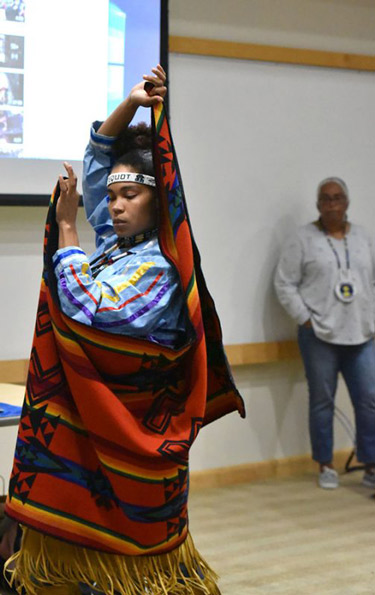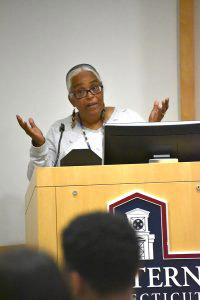- Apply
- Visit
- Request Info
- Give
Eastern Pequot Tribal Council Members Speak on Indigenous Peoples’ Day
Written by Vania Galicia
Published on October 17, 2019

Eastern Pequot tribal Council members Natasha Gambrell and her mother Valerie Braxton-Gambrell came to Eastern on Oct. 14 in honor of Indigenous People’s Day. Gambrell, a 2015 Eastern graduate and her mother shared the history of the Eastern Pequot and spoke about the current struggles their tribe faces today.
Gambrell began her presentation by recounting the history that has led her tribe to the fight they are in today to prove their existence. After the Pequot tribe was split into two in 1979, the Eastern Pequots and the Paucatuck Eastern Pequots, had to submit separate petitions for federal recognition. Although the Eastern Pequot originally put in their petition for federal recognition in 1979, it was not moved into the preliminary stage until 2000 and years later was completely removed. As of 2005, the Eastern Pequot Tribe in Gambrell’s words, “ceased to exist,” based on the decision of the U.S. Interior Department.
When Gambrell’s tribe was deemed “nonexistent,” she was 13 years old. “I witnessed genocide first hand that day,” she said. She continued to explain the generational traumas that have been passed down by generations before her and why she fights for her voice to be heard today.
She spoke about children who have been taken from indigenous families, and been have lost for generations prior to the Indian Child Welfare Act (ICWA). Enacted in 1978, the act allows adopted indigenous children to access information about their tribal ties; but anyone adopted prior to the act continues to be locked out of their documents today. Gambrell said she fights “to bring our kids home.”

Valerie Braxton-Gambrell. Photo provided by Intercultural Center.
Braxton explained further what federal recognition means for their tribe. “Federal recognition does not equal casinos, it means access to healthcare, education, mental health treatment and more.” Gambrell said, “My job is to make sure the next seven generations don’t have to fight like we have had to.”
Gambrell, shared the struggle her tribe has to keep their history and culture alive. Although she wore pieces of regalia to the event, she explained how they all were significant and treasured because of their scarcity. Her Eastern Pequot headband, which is no longer made, was passed down to her from her grandmother from the 1970’s. Her choker was given to her by her aunt and her ribbon shirt by her uncle.
Braxton also spoke of the difficulty of keeping her tribe’s language alive because of the generational erasure of indigenous people. She added that even into the 1970’s not all indigenous people were allowed to vote.
Gambrell also presented one of her tribe’s courting dances at the event. She has been dancing the “eastern blanket jingle” and “northern traditional” dances since she was seven. She described the blanket jingle she presented to be similar to a butterfly in a cocoon. She began the dance by swaying her blanket back and forth, picking up the speed of her dance as it continued. As the dance progressed she opened up her blanket more and more until it was fully open. Traditionally the dance would end with the dropping of the dancer’s blanket in front of the man they want to marry.
Braxton and Gambrell invited all in attendance to their annual powwow, held every fourth Sunday in July. To learn more about the Eastern Pequot and their efforts to fight for federal recognition visit http://easternpequottribalnation.org/.


